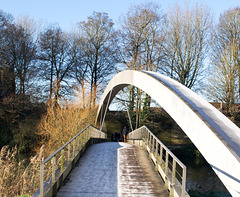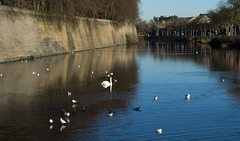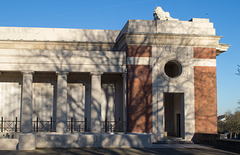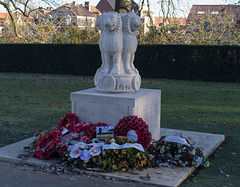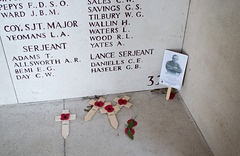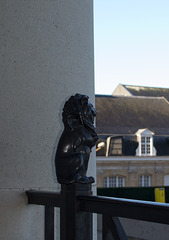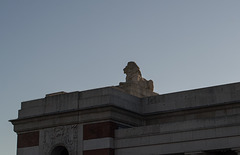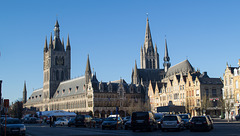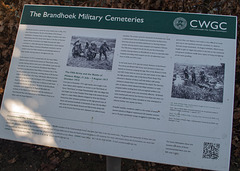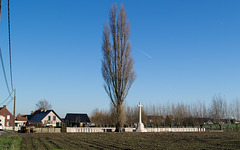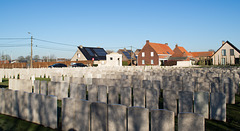
Europe2016
Belgium Ypres (#0271)
| |
|
|
|
Goats, along a remaining portion of the fortress (and moat) that surrounded the old town of Ypres.
Belgium Ypres (#0273)
Belgium Ypres (#0274)
| |
|
|
If you look closely (and past the frost, it was below freezing), you can see in the distance a passageway through the town wall.
Belgium Ypres (#0277)
| |
|
|
|
This started out to be a picture of the swan, but because of the light and that the swan didn’t stop, it become two subjects:
Birds: There seemed to be some birds (the smaller white ones) that had the calls of sea birds (Ypres is about 40k from the coast), I don’t know what the small and pretty blue birds are, AND note that some of the birds are standing on ice.
Wall: The fortress around the southeast side of Ypres has portions which date back to the 1300’s, though obviously there’s been many modifications over the centuries. The sections of the fortress on the north and west sides of Ypres were removed in the late 1800’s to allow for expansion.
Belgium Ypres Menin gate (#0286)
| |
|
|
The Menin Gate Memorial to the Missing. The memorial is dedicated to British and Commonwealth soldiers killed in the Ypres Salient during WWI AND whose bodies have not been found. The memorial is maintained by the Commonwealth War Graves Commission and was unveiled in 1927. The memorial contains the names of 54,395 soldiers who died in the Ypres Salient before August 15, 1917 and whose bodies have not been found or identified; though a large number of deaths, this is less than 1% of the 8 to 12 million military deaths during WWI.
The Menin Gate is well-known for a ritual that has occurred every night (except during WWII German occupation) since the gates opening in 1927. The ritual was created by the citizens of Ypres to honor the role of the British in preserving Belgium’s freedom. The ritual involves buglers from the local fire brigade playing “Last Post” at 20:00 (8 PM); the ritual is attended by 1000’s, though on the night I went it was near freezing and there were ‘only’ probably about 300.
See: en.wikipedia.org/wiki/Menin_Gate
Belgium Ypres Menin gate (#0281)
| |
|
A portion of the Menin gate, seen from the fortress (Ramparts). From the density of the names on the walls, you can begin to get a sense of the volume of names.
Belgium Ypres Menin gate (#0282)
| |
|
At the Menin gate, a separate memorial to Indian soldiers killed fighting in the Ypres Salient for the Commonwealth.
Belgium Ypres Menin gate (#0290)
| |
|
A small segment of the list of names of Indian soldiers whose bodies have not been found. It wasn't until visiting this memorial that I had an appreciation for the number and range of Commonwealth soldiers killed in WWI.
Belgium Ypres Menin gate (#0291)
| |
|
Belgium Ypres Menin gate (#0292)
| |
|
At the time that I was there, I was surprised at the number of lion figures at the memorial, including this one here on a banister. At the time I thought it was used as the British use the lion as a national symbol or pride. I have since learned that the lion is also used as a symbol by the people of Flanders (the Flemish people); Ypres is in the Flemish section of Belgium.
Belgium Ypres Menin gate (#0293)
Belgium Ypres (#0298)
| |
|
|
Returning to central Ypres from the Menin gate one comes to the market square and the Cloth Hall (the long hall on the left side of the picture) in the center of Ypres. The hall was built in the 1300's at a time when Ypres was widely known for its textiles and linen. The building was almost completely leveled by German bombing in WWI, this is a faithful replica of the original.
Belgium Brandhoek Military Cemetery (#0300)
| |
|
“You smug-faced crowds with kindling eye Who cheer when soldier lads march by, Sneak home and pray you’ll never know The hell where youth and laughter go.” ― Siegfried Sassoon
I first became interested in WWI when a member of my gay family used Siegfried Sassoon’s poetry in a discussion he was leading for a course I was teaching on masculinity and gender in the early 1980’s. Questions of the legitimacy of military action had first become salient to me when I had to make decisions about my own military service during the Vietnam war, but it wasn’t until a few years after that service that I began to gain the skills to understand how those in power use cultural tactics to legitimize their use of other young men (except their sons) in the war machine; a machine that all too often was used to further the status of civilian power-holders. The sentiments expressed by Sassoon were an important part of starting me down the road of questioning both the use of military power, and how we sell such use. It is this questioning of how the population is convinced to accept the use of their children and partners as fuel for the military that brought me to close observation of how we use memorials as a way to wrap up the justification for a war and the actions of that war.
My specific interest in WWI dates back to Sassoon having played an important part in my awakening to these issues, was furthered by the extent that WWI was the first large scale ‘industrial’ war with the associated horrors, and was aided by the extent that the justness of specific actions in WWI was much less clear than was the justness of WWII.
I should note at this point that I’m not strictly anti-war. I do acknowledge that there can be wars that are clearly ‘just’ (e.g., WWII), but even within those there are actions where the use of troops seems to be mostly for furthering the status of those with power, not resolving the issue. My cynicism is fed by the fact that as someone from a working-class background, I did not have the options of choosing college to avoid military service during the Vietnam war. If the war was ‘just’, then why was it fought more by the working-class, and much less so by the middle and upper class?
….
What is shown here is the entrance to the Brandhoek Military Cemetery, one of three Commonwealth cemeteries in the small town of Brandhoek. My initial plans had been to view some of the very striking memorial sculptures across Flanders (parts of Belgium and northern France) that memorialize the war, but it quickly became apparent that time demands were going to require my putting off traveling to most of those until a future trip. I thus decided to put my focus into viewing some of the cemeteries around Ypres; an approach which I quickly realized was going to be far more moving than I expected.
Belgium Brandhoek Military Cemetery (#0302)
| |
|
Within the entrance gate, a plaque denoting that land for the cemtery was a gift of gratitude by the Belgian people to those who died in the war. This statement seemed odd when I first saw it, but as I began to see how much land in the area was cemeteries for WWI, it made more sense. All signs were presented in English, French, and Dutch.
Belgium Brandhoek Military Cemetery (#0305)
| |
|
Brandhoek Military Cemetery, one of three cemeteries in very close proximity in Brandhoek (see nearby pictues). As suggested by the picture here, the cemeteries in Brandhoek are surrounded by the local village and farms. This cemetery contains 669 burials from WWI battles prior to 1917. See next picture regarding the placement and size of the cemeteries.
Belgium Brandhoek Military Cemetery (#0311)
| |
|
|
A plaque describing the Brandhoek military cemeteries, along with pictures of the conditions in the area during WWI. Brandhoek was a relatively safe spot near the war zone and thus dressing stations (field hospitals) were situated there; fatalities were buried near those facilities. The Brandhoek Military Cemetery was opened in 1915 adjacent to the station; the Brandhoek New Military Cemetery and Brandhoek New Military Cemetery no 3 were opened nearby in 1917. Together the three cemeteries have 2201 burials.
The cemeteries along with other Commonwealth cemeteries in the area are maintained by the Commonwealth War Graves Commission, which has an excellent website: www.cwgc.org/about-us.aspx
Belgium Brandhoek New Military Cemetery No 3 (#030…
Belgium Brandhoek New Military Cemetery No 3 (#030…
| |
|
|
|
The Brandhoek New Military Cemetery No 3 was used for burials for 10 months, from August 1917 to May 1918; it contains 975 burials. The Brandhoek New Military Cemetery (without a number) is behind the houses with the visible solar panels, there is a narrow path between those houses to get to the cemetery (see nearby picture).
Detailed information for this and other cemetery descriptions comes from the website of the Commonwealth War Graves Commission.
Jump to top
RSS feed- Latest items - Subscribe to the latest items added to this album
- ipernity © 2007-2024
- Help & Contact
|
Club news
|
About ipernity
|
History |
ipernity Club & Prices |
Guide of good conduct
Donate | Group guidelines | Privacy policy | Terms of use | Statutes | In memoria -
Facebook
Twitter



